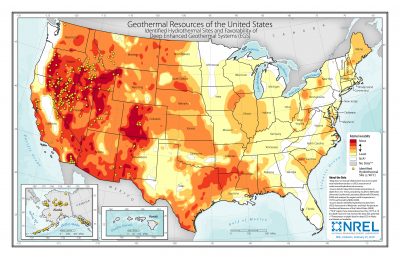Tapping the Earth’s Power
Geothermal power could play an important role in decarbonization.
There’s been a lot of recent interest in geothermal energy. It can complement other renewables as they become a bigger part of the power mix. A recent study by DOE suggests that geothermal capacity could reach 60 Gigawatts by 2050.
The basic technology is pretty simple: drill down into a reservoir of super-hot water (up to 700 °F), then use the water to run turbines. The wells have various depths, sometimes up to two miles. If the water is below 360 °F, it’s often used to vaporize some other fluid, which is then used to run the turbine. The water creates enough powerful steam to run the turbines directly. Either way, let the water cool, pump it back underground. Rinse and repeat.
The economics of geothermal are complicated. The up-front capital costs mean that the levelized cost can be two or three times as much as utility-scale solar. But the big advantage of geothermal is that, unlike other renewables, it’s available 24/7, no matter what the weather. Thus, it gets a higher capacity rating. You can replace 3000 megawatts of solar capacity with 1000 megawatts of geothermal. Putting aside cost, the biggest downside is probably the potential for small tremblors, much like fracking. That’s something to keep in mind in siting projects.
The attributes of geothermal become more valuable as solar and wind play a bigger part in the grid. A study by the Center for Energy Efficiency and Renewable Technologies indicates that geothermal could play a major role as California moves forward with decarbonization:
“At low penetration levels, integrating variable renewable resources like solar and wind is relatively easy and emphasis on the lowest cost renewables makes economic sense. But as renewable penetration increases, so do problems like lack of flexibility and over-generation in certain hours of the year, which raises costs, and changes the economic calculus. As California moves towards its 50% RPS, adding baseload geothermal reduces solar over-generation in the middle of light load days, causes fewer starts and stops in the gas fleet, lowers carbon emissions and the number of cap and trade allowances held by utilities, and reduces demand for the most expensive flexible resources.”
One way of decreasing the price of geothermal power is to use the steam for other purposes, as Utility Dive explains in a recent story. When power isn’t needed on the grid, it might be used to produce hydrogen, which can then be stored and used as a zero-carbon energy source. In some places, like California’s Salton Sea, the water may also be a source of valuable minerals such as lithium for batteries.
Geothermal power has one big limitation: it depends on geology. As you can see from this map, the distribution of geothermal potential within the U.S. is spotty:
The really high potential areas are all west of the Mississippi, and predominantly in the Western quarter of the country and along the southern border. But there are patches of potential scattered around in places further east where they could help balance the power grid.
Geothermal is a good example of a broader lesson. Wind, solar, and storage look to be the mainstays of the future grid. But we shouldn’t focus exclusively on a few technologies. Local circumstances are going to provide unique opportunities and challenges. We’re going to need a range of options to deal with those.
Reader Comments
One Reply to “Tapping the Earth’s Power”
Comments are closed.








While geothermal is available in many locales, especially in the western United States, and is available for thermal heating and cooling via heat pumps in many if not most places having accessible bedrock, as an energy source for electrical power, its available depends upon the locale, and, so, unlike most solar (excepting tree cover that can’t be cut), is not always accessible.
As a nationwide option, as you point out, it is attractive.
Unfortunately, as you note, it is not the most cost effective means of getting electrical power, if wind and solar and batteries are included in the mix. It may be more aesthetically acceptable to some communities.
However, I continue to seriously wonder about the values expressed by communities which do not want to decarbonize because of aesthetics, or claim wind turbines are noisy and a nuisance.
Gas compressor turbines are much noisier and yet, somehow, are more acceptable.